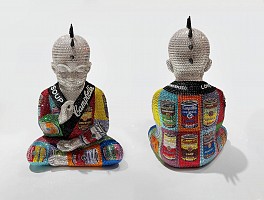BIOGRAPHY

Metis Atash views her sculpture as a fusion of worldly pleasure and spiritual insight. Upon first glance, their shiny surfaces and bright colors are unmistakable, though much like the human beings they resemble, their complexity lies within. As a child growing up in the 1970’s and 1980’s, Metis was heavily influence by music. She felt drawn to Punk Rock with its rejection of the mainstream and perceived excesses. This feeling continued into adulthood, when Metis chose to relinquish a successful corporate life for an artistic one. She found the source of her artwork in Bali, after much time spent embracing the authenticity and love of its people.
The approach to sculpture requires a form, and Metis’ choice is reflected literally as the form of Buddha. This shape implies a relationship to Siddartha Gautama, and to Buddhism. Siddartha’s teachings were based on the idea that we exist in a constant state of craving, or want. This endless cycle creates an attachment to impermanent worldly things and pleasures. According to Siddartha, only by recognizing these desires may they be extinguished. The physical act of creating these sculptures is also linked to Buddhism’s ascetic fundamentals. Ascetics have historically withdrawn from the world for their religious practice, and adopted a lifestyle of extreme austerity and reflection. Two examples of this practice are seen in the creation of Buddhist sand mandalas, and even Christian illuminated manuscripts. The intensely detailed work offers solitary monks a profound state of concentration. This kind of ‘escapism’ is also found in the repetitive placing of tiny crystals that cover each Buddha sculpture. Although these works are not intended for religious purposes, the simple act of creating them is meditative.
For the majority of us, it is impossible to completely ignore our need. We can only hope to balance our spiritual and physical lives, and this perpetual contradiction is mirrored in Metis’ sculpture. One series in particular, has clear ties to consumerism with a nod to high end fashion. In these works, Buddha is clothed in extravagant Chanel or Balmain, though he maintains an unyielding prayer pose. A second series is based on important artists, with each sculpture covered in the imagery of Yayoi Kusama, Jean-Michel Basquiat, or Andy Warhol. The irony of these works is not lost in a society where art has developed into a status symbol, or simply just another set of elite objects to covet.
It is not the artist’s intent to ignore the physical, but rather to fuse it with her spiritual being. Through these sculptures, we are reminded that it is possible to have both. In Metis’ words “Finding a peaceful balance and letting these two worlds not only gracefully coexist but also embracing their discrepancies and challenges, is the way to happiness for me. I believe that most people are searching and yearning for something greater than them. I believe that we come from compassion and a willingness to explore, to understand and to connect. That is our true nature.”
---Cristin Longo
